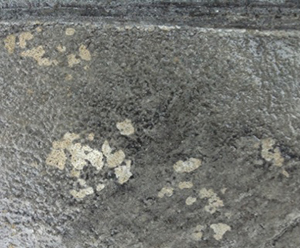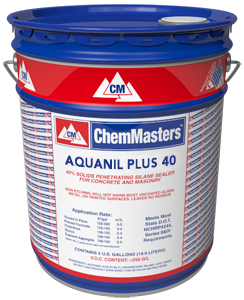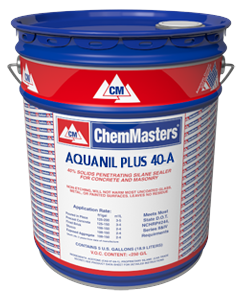 |
 Seal the Deal
Seal the Deal
ChemMasters Newsletter: Vol 3 Issue 1
Using Deicing Chemicals - Good or Bad Idea?
The question of whether or not to use deicing chemicals on your exterior pavement is relative to the potential for (and costs of) slip and fall accidents on your property and methods employed to protect your exterior concrete. The benefits of using deicing chemicals are obvious… they melt ice and snow to help prevent injuries. But doing so may require extra care to protect your concrete from some undesirable side effects.
The decision on whether or not to use deicing chemicals must begin with an understanding of freeze/thaw cycles and their impact on concrete.
Freeze/Thaw Cycles – What are they?
The term “freeze/thaw cycle” describes the process by which water repeatedly freezes, melts and refreezes. This cycle occurs naturally during winter months as temperatures fluctuate above and below freezing (32° F or 0° C). The frequency of freeze/thaw cycles has a dramatic impact on the long-term durability and aesthetics of exterior concrete pavement.

Freeze/thaw cycles damage concrete when ice or snow melts & re-freezes.
Concrete has often been described as a “hard sponge” due to its high porosity and ability to absorb substantial quantities of liquids like water. When temperatures dip below 32° F (0° C) during winter months, the water absorbed within concrete will freeze and expand, exerting high tensile forces on the concrete in which it is constrained. Concrete has very high compressive strength, a measurement of how well it can withstand an external force that wants to compact it, like the weight of a car rolling over a driveway. But it has relatively weak tensile strength, a measurement of its ability to withstand an internal force that wants to tear it apart from the inside out. In fact, concrete’s tensile strength is only about 1/10th its compressive strength.
Water that freezes will expand as it becomes ice to occupy a larger space than its liquid form; typically a 9% increase by volume. As anyone who has left a beverage in the freezer for too long can attest, that expansion will exert a substantial force on anything that may constrain it. Who hasn’t been impressed (and inconvenienced) by the forces necessary to violently burst a plastic or glass bottle as the water inside froze?
When water freezes within concrete to create tensile forces sufficient to “burst” it apart, it creates a condition known as “scaling” or “delamination” in which thin sections of the pavement surface become dislodged. Sometimes a lightweight aggregate near the pavement surface will absorb enough water, freeze, and create a “pop out” of the concrete paste above it. The effects of freezing water are cumulative, damaging concrete during each cycle in which the water freezes and expands.
Depending on where you live, the number of naturally occurring freeze/thaw cycles can vary significantly. According to the National Climatic Data Center, these are a few annual averages in various cities:
| City | Cycles | City | Cycles | City | Cycles |
| Albuquerque, NM | 91 | Chicago, IL | 56 | Minneapolis, MN | 58 |
| Billings, MT | 77 | Columbia, SC | 43 | New Orleans, LA | 8 |
| Birmingham, AL | 38 | Detroit, MI | 47 | Reno, NV | 123 |
| Boston, MA | 47 | Little Rock, AR | 42 | Rock Springs, WY | 104 |
| Buffalo, NY | 53 | Louisville, KY | 45 | St. Louis, MO | 46 |
| Chattanooga, TN | 48 | Macon, GA | 30 | Winslow, AZ | 104 |
It’s surprising how often “southern” cities experience high numbers of naturally occurring freeze/thaw cycles. While many northern cities get cold, stay cold, and don’t warm up to experience another freeze/thaw cycle, those southern cities often experience temperature variations that fluctuate repeatedly above and below freezing. Consequently, naturally occurring freeze/thaw damage can and does occur further south than might otherwise be expected.
Deicing Chemicals - Impact on Freeze/Thaw Cycles & Reinforcing Steel

Freeze/thaw cycling and deicing chemicals can cause surface paste to scale or delaminate.

Pop outs occur when an water accumulates in an absorptive aggregate, freezes and bursts.
To make matters worse, some concrete ends up undergoing many more freeze/thaw cycles than those that happen naturally. Manmade freeze/thaw cycles occur each time deicing chemicals are used to melt ice and snow on sidewalks, steps, driveways, etc. During a week in which the temperature never exceeds 32° F (0° C) and no natural freeze/thaw cycles occur, the use of snow and ice melting salts and deicing chemicals may create dozens of artificial freeze/thaw cycles each time they are applied. As a result, concrete may experience far more freeze/thaw damage than might otherwise be expected.
But additional freeze/thaw damage is not the only hazard to concrete from use of deicing chemicals. The term “deicing chemicals” encompasses a wide variety of products that generally melt ice and snow. Some common chemistries include:
- Calcium Chloride
- Calcium Magnesium Acetate
- Magnesium Chloride
- Potassium Chloride
- Sodium Chloride / Rock Salt
- Urea / Carbonyl Diamide
As you can seem most of these products are versions of chloride (salt). Excessive use of chlorides can, over time, damage concrete by reducing its naturally high pH level which can result in “chalking” (deterioration) of concrete, and oxidation of reinforcing steel like rebar. That oxidation causes the steel to expand as it rusts, and like freezing water, that expansion creates high tensile forces that can result in delamination of the concrete surface down to the rebar depth.
This type of delamination is catastrophic, causing large portions of concrete to become dislodged. It’s the same process that leads to formation of those bone jarring potholes on roads, highways and bridges.
Conclusions
Ultimately, the decision on whether or not to use deicing chemicals is a personal one based upon many factors and with full knowledge of their benefits and shortcomings. Here are some issues to consider when making that decision:
- Concrete Maintenance – Is your concrete sealed to prevent absorption of water and chlorides (salts)? Sealed concrete is better protected from damage caused by freeze/thaw cycles and deicing chemicals. Penetrating silane and siloxane sealers offer superior protection on smooth or broom finished concrete without changing its surface or appearance.
- Concrete Profile - Smooth finished concrete is more likely to be hazardous when wet or icy than textured or profiled concrete.
- Foot Traffic - The number of people using that walkway, and their frequency. Obviously, more traffic means a greater chance of an accident occurring.
- Stairs or Steps – Walking up or down stairs, steps or inclines will increase the hazards associated with wet or icy surfaces.
- Age & Mobility – The very young and very old may be more prone to slip and fall accidents in less than ideal conditions. Does anyone in your household or building have mobility issues that might increase their risk?
- Purpose – Is the walkway public/municipal property or does it support a commercial business where issues of liability may be more prevalent?
- Grade – Is your concrete on a slope or grade that may increase the potential to slip and fall in ice and snow?
 Aquanil™ Plus 40
Aquanil™ Plus 40
Penetrating Silane Concrete Sealer & Waterproofer
Aquanil™ Plus 40 is a penetrating, chemically-reactive 40% solids alkyltrialkoxy silane, solvent-based silane sealer. It repels moisture and water from concrete and masonry.
 Aquanil™ Plus 40-A
Aquanil™ Plus 40-A
Low-VOC, Solvent Based, Penetrating Silane Sealer for Concrete & Masonry
Aquanil Plus 40-A is a penetrating, chemically reactive alkyltrialkoxy, 40% solids, solvent based silane sealer that repels moisture and water from concrete and masonry.
 Aquanil™ Plus 100
Aquanil™ Plus 100
Penetrating Silane Sealer for Concrete and Masonry
Aquanil Plus 100 is a penetrating, chemically reactive alkyltrialkoxysilane ›95% solids, solvent based silane sealer that repels moisture and water from concrete and masonry.
 Spall Guard WB 10
Spall Guard WB 10
Penetrating Siloxane Low-VOC Water-Based Concrete Sealer & Waterproofer
SpallGuard WB-10 a penetrating, chemically reactive, solvent-free, silane modifed siloxane emulsion designed to be a moisture and water repellent for concrete and masonry.
Silencure, Polyseal, Traz, Aquanil, Spall Guard, Chemisil, EZ Strip Cure, SafeSeal, Spray Film, DuraShield SRT, Slip Stop and Exposee are trademarks of ChemMasters, Inc. ChemMasters and Safe-Cure are registered trademarks of ChemMasters, Inc.
300 Edwards Street, Madison, Ohio 44057
Phone 440.428.2105 - 800.486.7866
Fax 440.428.7091
Silencure, Polyseal, Traz, Aquanil, Spall Guard, Chemisil, EZ Strip Cure, SafeSeal, Spray Film, DuraShield SRT, Slip Stop and Exposee are trademarks of ChemMasters, Inc. ChemMasters and Safe-Cure are registered trademarks of ChemMasters, Inc.

Phone 440.428.2105 - 800.486.7866
Fax 440.428.7091
ERISA Documents for Welfare Benefit Plan
